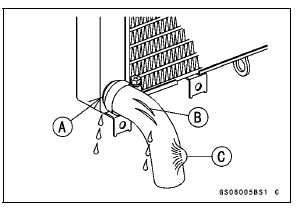

The high pressure inside the radiator hose can cause coolant to leak [A] or the hose to burst if the line is not properly maintained.
Squeeze the hoses. A hose should not be hard and brittle, nor should it be soft or swollen.
Replace the hose if any fraying, cracks [B] or bulges [C] are noticed.
Torque - Water Hose Clamp Screws: 3.0 N┬Ęm (0.31 kgf┬Ęm, 27 in┬Ęlb)

 Coolant Level Inspection
Coolant Level Inspection Engine Top End
Engine Top EndInner Tube Inspection
Visually inspect the inner tube [A].
If there is any damage, replace the inner tube. Since
damage to the inner tube damages the oil seal, replace
the oil seal whenever the inner tube is replaced.
NOTICE
If the inner tube is badly bent or creased, replace
it. Excessive bending, followed by ...
Exploded View
5. Other than US, CA, and CAL Models
6. The big diameter side of the dampers faces upward.
G: Apply grease.
L: Apply a non-permanent locking agent.
R: Replacement Parts
S: Follow the specified tightening sequence.
SS: Apply silicone sealant.
11. Immobilizer Ampli ...
Spring Preload Adjustment
Remove the rear shock absorber from the frame (see
Rear Shock Absorber Removal).
Loosen the locknut and turn out the adjusting nut to free
the spring.
Special Tools - Hook Wrench T=3.2 R37: 57001-1539
Hook Wrench R=35: 57001-1580
To adjust the spring preload, turn in the adjusting n ...